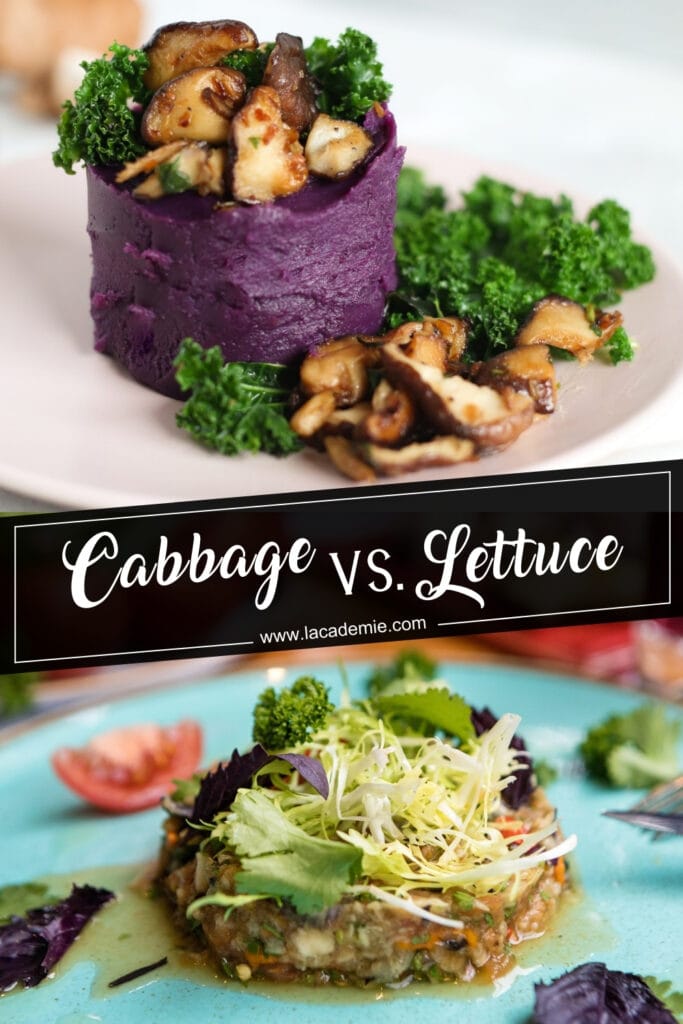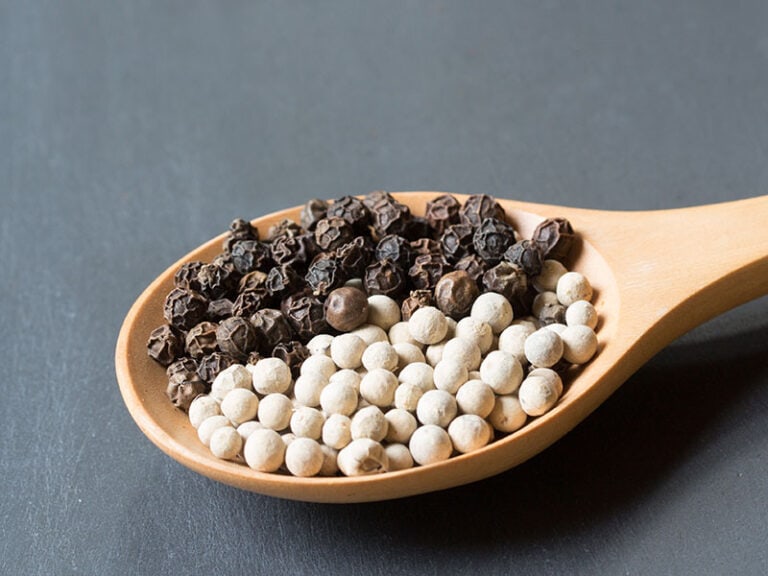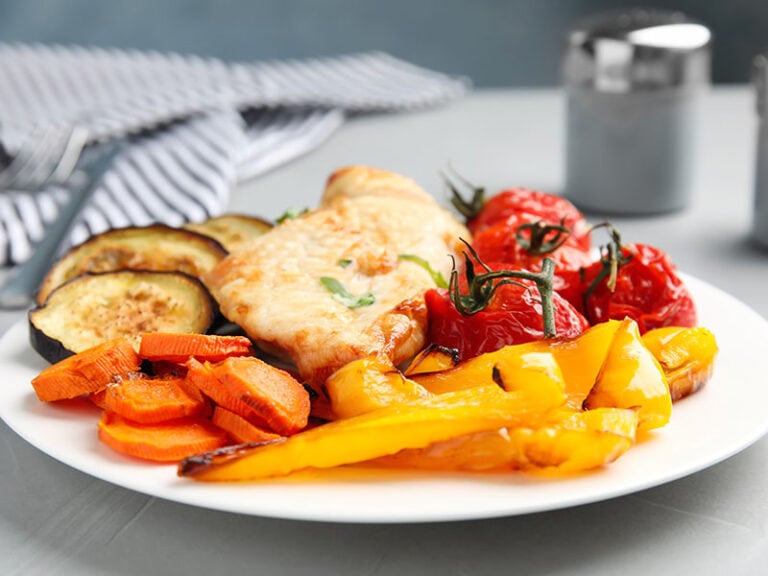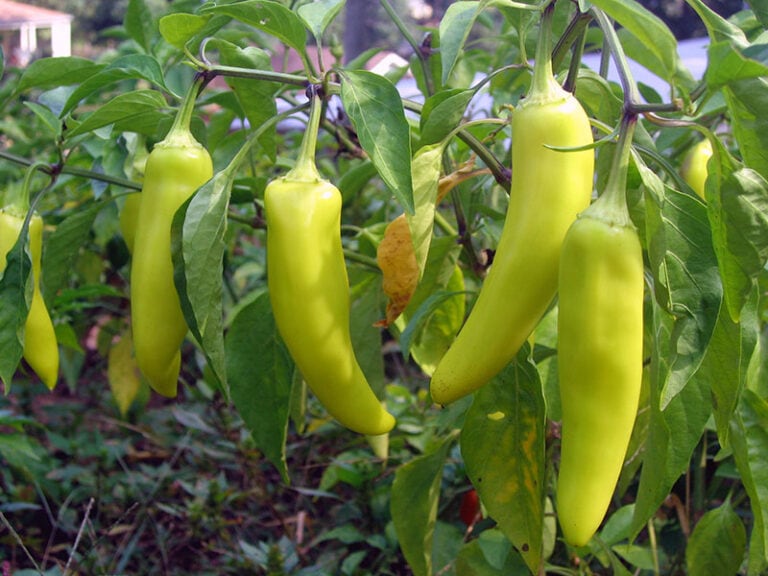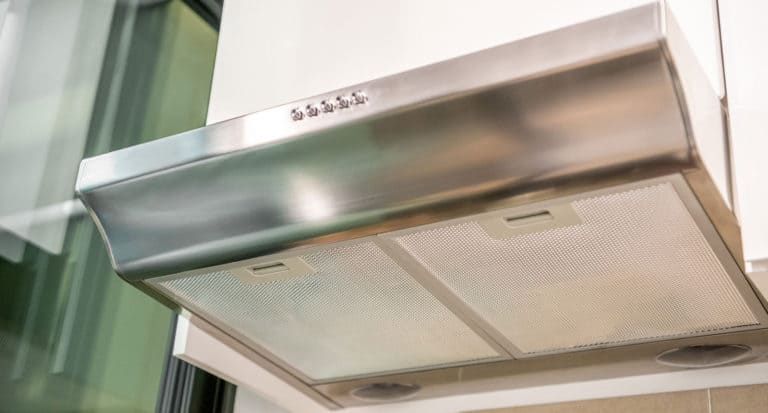Here is the ultimate cabbage VS lettuce guide that will help you understand the most important differences between the two.
A while ago, I found myself in the supermarket looking to buy lettuce for the upcoming picnic. I ended up with the Napa cabbage and first started to think about the difference between the cabbage and lettuce. I believe I am not the only one who was confused with the two green leafy veggies.
As I want to have a healthy diet and take as many beneficial nutrients from my food as possible, especially during the pandemic, I decided to compile all the information I discovered in one place.
So, you follow my lead and know which one of the two vegetables is better for your health. Additionally, if you are up to start a new hobby, and grow your own food, you will find the differences in growing conditions useful.
One thing is sure, if you are looking for healthy food to help you lose a couple of pounds, cabbage and lettuce come to the top of the list. Hence, learn more about them to include them properly in your daily meals.
But, before we hop on to the essential differences, let’s see what cabbage and lettuce varieties are available on the market.
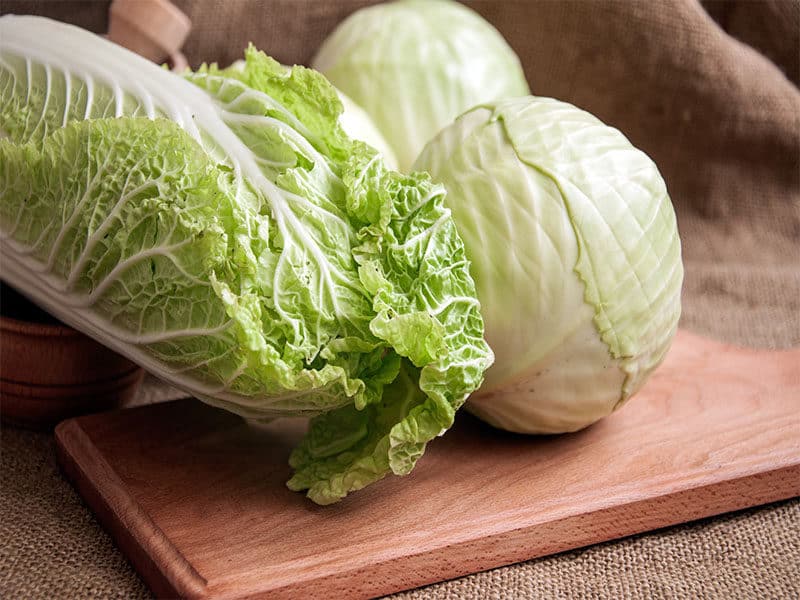
Cabbage Varieties
The usual classification of the cabbage varieties is by color, and most people think there are only two cabbage varieties – red and green. But, there are seven cabbage varieties you can include in your diet.
- Green Cabbage – Cannonball Cabbage
- Red Cabbage – Purple, Red Kraut
- Bok Choy
- Choy Sum
- Napa Cabbage
- Savoy Cabbage
- January King Cabbage
The cabbage varieties differ in their shape and color and use in the kitchen. Green cabbage is the most common one, versatile and delicious. Choy varieties are used in Chinese cuisine, they are smaller and have more narrow shapes.
Napa cabbage is sweet and soft, while the Savoy variety is tenderer. January King cabbage is best when roasted with butter, and red cabbage is perfect for salads.
Lettuce Varieties
Lettuce is a common ingredient in salads and sandwiches, but did you know there are five main types of lettuce with numerous varieties for each type.
The five varieties are:
- Leaf
- Cos (romaine)
- Crisphead
- Butterhead
- Stem (asparagus lettuce)
Leaf lettuce is the most common type, featuring crisp leaves on the stalk. Romane or cos lettuce type has an elongated head, while butterhead type has small soft, soft leaves with loose heads.
Stem lettuce is common in Chinese cuisine and has large seedstalks. Crisphead varieties are sensitive to heat and available in supermarkets.
A widely used variety of iceberg lettuce is crispbread, and it’s a common ingredient in burgers. Fresh iceberg lettuce can make store-bought, pre-cooked frozen burgers taste delicious! If you’re too busy to cook for yourself, why don’t you consider trying this tip out?
Many salads include iceberg lettuce as the main ingredients, especially those that are served as an accompanying dish for pork chop. I’d suggest combining iceberg salad with blue cheese for an exciting flavor dynamic. Don’t forget to throw in some fresh tomatoes and crispy bacon too!
Watch this video to know more:
Cabbage Vs. Lettuce: Differences
Cabbage and lettuce look alike, and some people often mix them. Apart from a similar look, cabbage and lettuce have little in common.
So, what are the differences between lettuce and cabbage? How to store them properly? Should I freeze my cabbage? Will lettuce go bad if it’s frozen? All of these questions will be answered in this article. Now, let’s get started.
Botanical Classification
Lettuce and cabbage are two distinct vegetables with different botanical classifications.
Cabbage belongs to the Brassicaceae family, species Oleracea. It is a close relative to, Brussel sprouts, broccoli, and cauliflower.
Lettuce is part of the Asteraceae family, genus Lactuca.
Growing Conditions
Lettuce and cabbage require different growing conditions and lettuce is annual, while cabbage is a biannual plant. First of all, lettuce grows in a warm area, but best in the shade. The ideal soil for lettuce is sandy soil with a pH level between 6 and 7.
The lettuce seed is small, so you need to provide well-tilled seedbeds. Also, lettuce doesn’t do well with weeds and requires occasional location shifting to prevent diseases in the soil.
On the other hand, cabbage thrives in cool areas, with a pH level of soil smaller than 6.5. Similar to lettuce, cabbage also requires changing locations to avoid some diseases. It is more prone to pests and diseases than lettuce and can be challenging to grow by beginners.
Because cabbage is a heavy feeder, you need to provide enough helpful nutrients and prepare the soil in advance.
Generally, lettuce is easier to grow because it requires less maintenance, has a simple sowing process, and better resistance to cold, pests and diseases. Both plants can be grown indoors, but cabbage will need more space and time to grow.
Additionally, the two vegetables should never be grown together, because their roots can affect each other and mess up with your crops.
Watch this video to know more:
Look
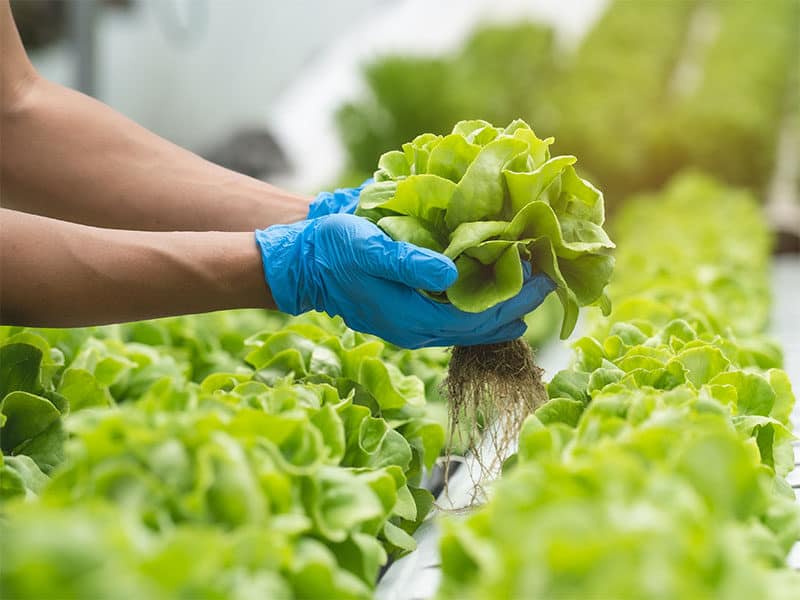
Some cabbage and lettuce varieties look very much like each other. For example, some people often take iceberg lettuce for green cabbage and vice versa.
Despite their similar appearance, cabbage and lettuce have distinct appearance characteristics.
Cabbage has a short stem and a bulb-shaped head. It is often green, with hard outer leaves. Inner leaves are softer and sweeter.
Lettuce, on the other hand, has green leaves wrapped around each other on short stems. Because lettuce leaves are softer, it gives the plant an oblong shape. In most cases, cabbage has a perfect, round shape.
Also, the green in lettuce is darker, because lettuce has more chlorophyll than lettuce. Some lettuce parts start to form flowers, but lettuce is picked before the flowering process begins. Lettuce flowering is called bolting.
However, the color shouldn’t be taken as a distinctive factor, because there are red and purple varieties on both sides.
Nutrients
The nutritive value of cabbage and lettuce depends on the varieties compared. I will compare the two most common and widely used Romaine lettuce with green cabbage.
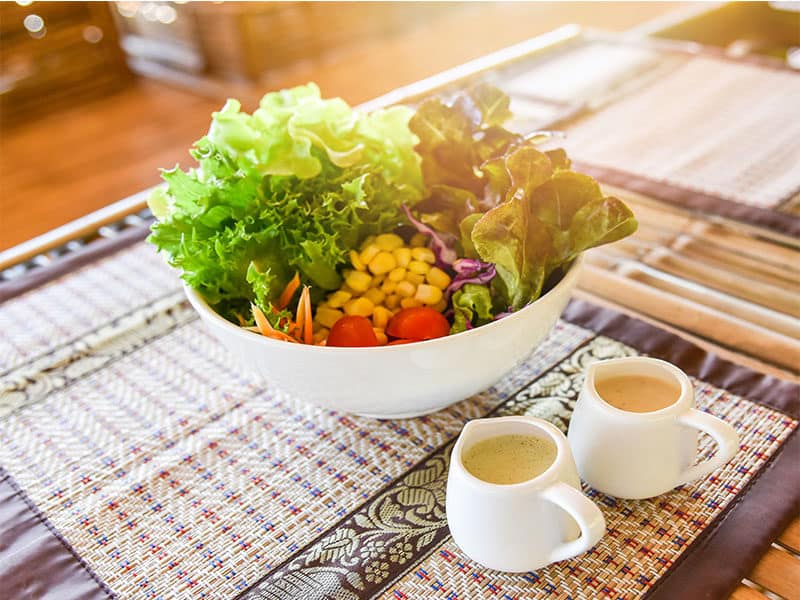
Water Content
Cabbage and lettuce, like many other vegetables, have a high water level. However, cabbage has a denser and tougher texture, which comes from a lower water compound. Cabbage contains 92% of water.
That percentage is 95% for lettuce, which gives it a softer texture.
Vitamins
Green vegetables are a great source of vitamins, and it isn’t different with lettuce and cabbage. If you are looking to improve your diet, you should include both vegetables.
The primary vitamin in lettuce is vitamin A. Compared to cabbage, lettuce is richer in this vitamin up to 50 times. Other vitamins in lettuce worth mentioning are K, E, B1, B2, and B3. Did you know that a 100 grams serving of Romaine lettuce is enough to provide enough vitamins A and K recommended for daily intake?
Cabbage is rich in vitamin C over four times than lettuce. A 100 grams of cabbage serving contains half a dose of recommended daily intake of this vitamin.
Other vitamins that can be found in cabbage are B5 and B6.
Lettuce and cabbage don’t have vitamin D and vitamin B12.
Proteins
When it comes to proteins, there are no significant differences in the share of lettuce and cabbage. The difference is minor, around 0.1 grams of protein per 100 grams in favor of lettuce.
The amount of essential amino acids in cabbage and lettuce is almost identical, too.
Fats
The two vegetables also contain a similar amount of fat. Again, lettuce contains only 0.05 grams of fat more than cabbage per 100 grams.
However, the difference is in the fat type.
While lettuce has polyunsaturated fatty acids, cabbage includes saturated fatty acids.
To conclude, both vegetables have low-fat content.
Carbohydrates
If you are counting your carbohydrates to lose weight, lettuce is a better option for you. Per 100 grams, lettuce contains two times fewer carbohydrates than cabbage, only 2.9 grams.
Cabbage is, therefore, richer in dietary fibers, and those are 45% of whole carbohydrates share.
Also, the two plants contain different sugar types. Cabbage has sucrose and maltose, while lettuce features glucose and fructose.
Minerals
Lettuce and cabbage have an equal percentage of minerals magnesium and zinc.
Lettuce has more minerals than cabbage, with higher copper, phosphorus, iron, and potassium levels.
On the other hand, cabbage has less sodium and more calcium.
Calories
Cabbage and lettuce are low-calorie foods. If you are looking to lose weight, you should incorporate both of them. Cabbage has slightly more calories because it has more macronutrients. Per 100 grams, cabbage only has 25 calories, while lettuce has 15.
You can chop cabbage with a convenient and easy to use vegetable chopper, add dressing and eat fresh as a salad as a quick, healthy, and low-calorie snack.
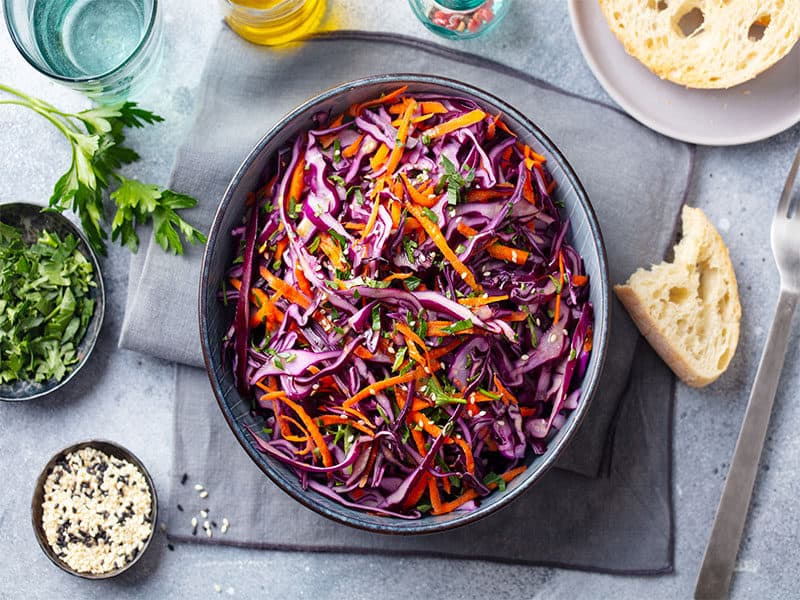
Acidity
Let’s now talk about cabbage and lettuce acidity. It affects the taste, but also the bacteria and fungi growth.
The growing conditions determine the acidity of cabbage and lettuce, but both vegetables are considered slightly acidic food. For comparison, the pH level of most lettuce varieties is between 5.9 and 6.2. Cabbage has a slightly wider pH range, with 5.2 to 6.8.
However, here is an important consideration. Cabbage and lettuce don’t form acids after consumption, which means they are alkaline. Some people might find it important for their diet or suffer from disrupted acid-base balance.
Glycemic Index
The glycemic index shows the relative glycemic rise in blood after consuming the food. Similar to other vegetables, cabbage and lettuce have a low glycemic index. Cabbage has 45, and lettuce has 32.
Comparison Table
Here is a comparison table containing the most important nutrient values for 100 grams of cabbage and lettuce. The expressed percentage is the percentage of recommended daily intake for adults.
Taste
The differences in taste depends on the variety and quality of the plant. But, as a vegetable-lover myself, I can notice the significant difference. Because lettuce has more water, it has a milder flavor and texture, less odor, despite the freshness.
Cabbage has an almost peppery flavor and a crunchy texture, which is more appealing than near bland lettuce taste.
Watch this video to know more:
Health Impact
Because cabbage and lettuce are great sources of beneficial macronutrients, their impact on human health shouldn’t be neglected.
Let’s see how cabbage and lettuce are good for your health.
Watch this video to know more:
Impact On Diabetes
Studies show that lettuce, specifically red variety, can improve conditions of fatty liver and has an anti-diabetic effect. Also, red cabbage and lettuce are an excellent source of antioxidant polyphenol that has many benefits, including reducing and controlling blood sugar level.
Cabbage can reduce oxidative liver stress and also control blood sugar levels. Therefore, cabbage and lettuce are considered helpful vegetables for people with diabetes.
Impact On Cardiovascular Health
The polyphenol help control blood pressure, improves the condition of blood vessels, and improve circulation. Moreover, this antioxidant reduces chronic inflammation, which reduces the risks of heart diseases.
Also, lettuce is rich in nitrate, so it reduces the risk of heart attack and stroke.
Impact On Cancer
Both vegetables have been associated with reduced risks of different types of cancers.
But, red lettuce proved to be the variety with the highest impact on the bladder, breast, colorectal, gastric, and other tumor types.
Other Benefits
Vitamin C in cabbage improves your immune system and boosts metabolism, improves the condition of your skin, and promotes bone health. Cabbage is also good for indigestion and helps you fight different microbial infections.
Lettuce promotes good sleep and keeps neuronal cells healthy. Also, it has antimicrobial properties and helps your muscles to relax.
Use In Recipes
Cabbage and lettuce aren’t that versatile in the kitchen, such as potatoes or other vegetables.
Because cabbage has a tougher structure, it holds up well during different cooking techniques.
You can boil or steam it, and use it in coleslaw. Cabbage is a common ingredient in vegan, Indian and Chinese recipes. My favorite combination is sauteed cabbage with lemon and garlic.
Lettuce is crunchy and commonly used fresh in salads and burgers, only seasoned with salt, lemon juice, and olive oil. Use premium culinary avocado oil for salad dressing to boost the crunchiness and lettuce taste.
Fun fact: although lettuce and cabbage don’t taste that much similar, they both are ideal replacements for arugula. Lettuce is most suitable for substituting arugula on pizza, whereas cabbage will make a fantastic ingredient in your soup.
Watch this video to know more:
Storage
When it comes to the average shelf-life of cabbage, it’s typical for cabbage to outlast lettuce. The length of time lettuce can stay fresh usually isn’t very long due to its high water content, which makes lettuce more susceptible to bacterial growth.
To store cabbage, you can simply cut it using a high-quality Chinese cleaver and store it unseasoned inside a refrigerator. That way, you will have it prepared for your meals.
On the other hand, even if you store your lettuce the correct way, it can only last for a couple of days in the refrigerator until it goes bad.
Both cabbage and lettuce can be frozen for extended shelf-life. However, you’ll need to blanch or cook these vegetables first. If frozen properly, cabbage and lettuce can last for months.
However, I always recommend you to eat these vegetables fresh to maximize the benefits.
Cabbage And Lettuce: Which One To Eat More?
As you can see, both vegetables are healthy and good for weight loss. You should incorporate both of them into your meals. I prefer cabbage cooked, and lettuce raw.
There are plenty of recipes you can find online to make delicious meals with these veggies. Cabbage looks like a slightly healthier option because it has more valuable nutrients.
Remember, the key to good overall health is well-balanced nutrition rich in fresh fruits and vegetables. Cabbage and lettuce are completely different vegetables, but similar in appearance and positive health impact.
Can you recognize cabbage and lettuce?
Don’t forget to like and share the article, if you enjoyed it!
